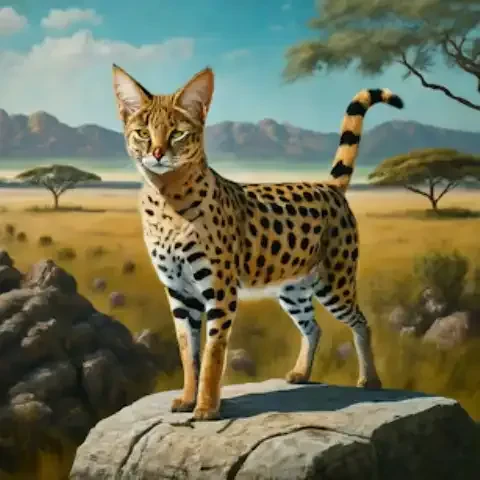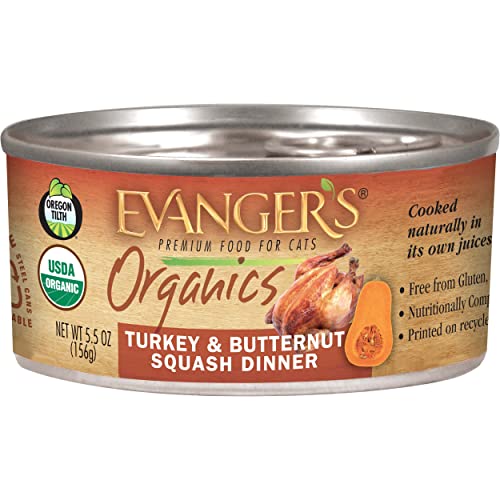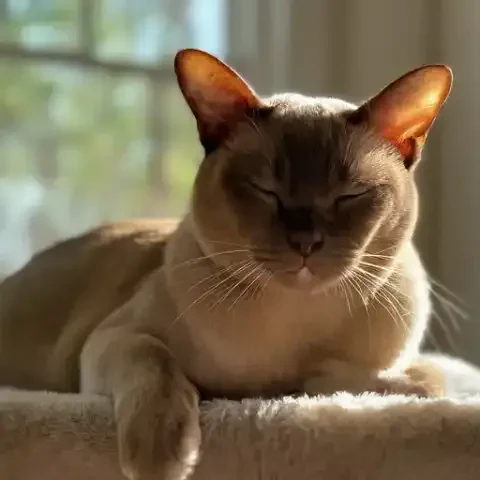Imagine a creature that moves with the lithe grace of a cheetah, boasts the striking spotted coat of a jungle feline, and yet seeks affection with a purr that resonates like a contented rumble. This is the Savannah cat, an extraordinary breed that embodies the captivating allure of the wild, domesticated just enough to share your life and home, but never quite losing that primal spark. Born from the deliberate crossing of domestic cats with the elegant Serval, an African wildcat, the Savannah is more than just a pet; it’s a living testament to the enduring fascination humans hold for the untamed beauty of the natural world. This article embarks on an exploration of the Savannah cat, venturing into its fascinating origins, marveling at its exotic physique, and delving into the unique personality shaped by its wild heritage. We will uncover the realities of living with a feline that bridges two worlds, domestic comfort and wild instinct, revealing what it truly means to share your life with a creature that so vividly embodies both the exotic and the untamed.
To truly understand the Savannah cat, one must first journey to the African savanna, the native habitat of its wild ancestor, the Serval. The Serval ( Leptailurus serval ) is a medium-sized wildcat, a creature of striking beauty and remarkable athleticism. With its long legs, slender body, and large, radar-like ears, the Serval is perfectly adapted to its grassy plains environment, a masterful hunter capable of leaping incredible heights to snatch birds mid-flight and possessing exceptional hearing to locate prey hidden in the tall grasses. Its coat, typically a golden yellow adorned with bold black spots and stripes, provides camouflage in its sun-drenched habitat, further emphasizing its exotic and distinctly wild appearance. The Serval is not a creature of gentle purrs and lap-cat tendencies; it is an independent, intelligent, and intensely driven predator, its very essence embodying the spirit of the wild African landscape. This untamed nature, this essence of the wild, is the very foundation upon which the Savannah cat breed is built. The Serval, with its inherent wildness, is not simply a distant ancestor; it is the blueprint from which the Savannah’s distinctive characteristics are drawn.
The genesis of the Savannah cat breed is relatively recent, born from a desire to capture and domesticate a hint of this wild elegance. The first intentional breeding of a Serval with a domestic cat is credited to Judee Frank in the mid-1980s, marking the dawn of a new and undeniably exotic feline breed. The motivation behind this unusual hybrid cross was clear: to create a domestic cat breed that possessed the striking appearance and captivating presence of a wildcat, while retaining the more amenable temperament and trainability of a domestic feline. The initial attempts were met with challenges, as hybrid breeding often is, requiring persistence and a deep understanding of feline genetics. Early breeders navigated the complexities of interspecies breeding, facing the unpredictable nature of hybrid offspring and the initial lack of breed recognition. Yet, the allure of the Savannah, with its unique combination of wild beauty and domestic possibility, proved irresistible, driving dedicated breeders to persevere in establishing this truly remarkable breed.
Understanding the Savannah cat breed requires grasping the concept of Filial (F) generations, a classification system that dictates how closely a Savannah cat is related to its Serval ancestor. The "F" designation followed by a number, such as F1, F2, F3, and so on, indicates the number of generations removed from the Serval parent. An F1 Savannah is the most direct hybrid cross, possessing a Serval parent and a domestic cat parent. These F1 Savannahs are the closest to their wild ancestry, typically exhibiting the most pronounced Serval traits in terms of appearance, size, and temperament. F2 Savannahs have a Serval grandparent and an F1 Savannah parent, further diluting the wild bloodline but still retaining a significant portion of Serval characteristics. F3 Savannahs have a Serval great-grandparent and an F2 Savannah parent, and so on, with each subsequent generation becoming progressively more removed from the original Serval ancestor. The F-generation number is crucial, as it directly impacts the cat's physical characteristics, temperament, and even care requirements. Earlier generations, like F1 and F2, tend to be larger, more physically imposing, and exhibit more pronounced "wild" behaviors, demanding more specialized care and experienced ownership. Later generations, such as F4, F5, and beyond, become progressively smaller, more domesticated in temperament, and generally easier to manage as household pets, though still retaining a distinct exotic charm and higher energy levels compared to typical domestic breeds. It is important to note that even within each generation, there can be variability; genetics are not always perfectly predictable, and individual Savannah cats, even within the same litter and generation, can exhibit a range of traits and temperaments.
The Savannah cat's journey to breed recognition was a testament to its undeniable appeal and the dedication of its breeders. Despite initial skepticism from some within the cat fancy, the Savannah's striking appearance and unique qualities eventually garnered attention and admiration. The International Cat Association (TICA), a major cat registry, granted preliminary breed recognition to the Savannah cat in 2001 and full breed championship status in 2012. This recognition was a watershed moment, solidifying the Savannah's place among pedigreed cat breeds and opening the door for wider acceptance and responsible breeding practices. Even with breed recognition, the Savannah remains a relatively new and still developing breed. Breeders continue to refine the breed standard, striving for consistency in type and temperament while maintaining the desirable exotic traits that make the Savannah so unique. The Savannah cat’s story is one of ongoing evolution, a breed still being shaped and defined, always balancing its wild heritage with the demands of domestic life.
The Savannah cat’s physical presence is nothing short of breathtaking, a living embodiment of exotic elegance. Their size alone commands attention, particularly in the earlier generations. Compared to the average domestic cat, Savannahs, especially F1 and F2 generations, are significantly larger and more imposing. They can reach impressive heights at the shoulder, often standing taller than many dog breeds, and possess a lean, muscular physique that speaks to their athleticism and power. Males tend to be larger than females, further emphasizing their statuesque build. This is not a delicate feline; the Savannah is built for strength and agility, a reflection of its wild ancestry. Their build is tall, slender, and muscular, a harmonious blend of power and grace. They are not bulky or heavy-set; instead, they possess a lithe, athletic build that allows for incredible agility and impressive leaping abilities. This physical prowess is not just for show; it translates into a dynamic and energetic cat, always ready for action and play.
The Savannah cat's coat is a masterpiece of natural artistry, a canvas adorned with bold spots and striking patterns reminiscent of its Serval heritage. The spotted coat pattern is perhaps the most defining visual characteristic of the breed, instantly evoking images of wild African felines. The spots are typically bold, well-defined, and scattered across a lighter background color, creating a dramatic and eye-catching contrast. The accepted coat colors and patterns for Savannahs include the classic brown spotted tabby, evoking the traditional Serval look, the cool silver spotted tabby, offering a more modern and sophisticated palette, and the solid black and black smoke variations, presenting a sleek and panther-like aesthetic. Regardless of the specific color or pattern, the Savannah coat is always striking and visually captivating, a testament to its exotic origins. The contrast between the dark spots and the lighter base coat is particularly pronounced, further emphasizing the wildcat-like appearance. The spots themselves can vary slightly in size and shape, adding to the natural and organic feel of their coat, no two Savannahs are exactly alike in their spotted design.
Complementing their spotted coats are their ears, another unmistakable feature contributing to their wild appearance. Savannah cats possess large, tall, and rounded ears, often set high on their heads, giving them an alert and perpetually attentive expression. These prominent ears are not just visually striking; they are also highly functional, inherited from the Serval's exceptional hearing capabilities. The size and shape of their ears contribute significantly to their overall wildcat aesthetic, further enhancing their exotic charm. The ears are often rounded at the tips, adding to their distinctive silhouette, and their placement high on the head accentuates their tall, slender build. These ears are always seemingly alert, constantly twitching and swiveling, reflecting their heightened senses and inquisitive nature.
Their legs are long and powerful, further contributing to their impressive height and athletic prowess. These elongated limbs are not just for show; they enable the Savannah to leap incredible heights, run with impressive speed, and move with remarkable agility. Their long legs are a key factor in their distinctive gait, characterized by powerful strides and a fluid, graceful movement that is both captivating and mesmerizing to observe. They move with a confident and athletic stride, covering ground quickly and efficiently, their movements conveying a sense of power and agility. Whether they are stalking a toy, exploring their environment, or simply moving across a room, their gait is always a reminder of their wild heritage and inherent athleticism.
Savannah cat eyes are captivating, typically almond-shaped and expressive, adding to their overall allure. Eye color can vary, ranging from vibrant green to warm gold or rich brown, often complementing their coat color and further enhancing their exotic appearance. Their facial features, beyond their eyes, also contribute to their wildcat-like structure. Their facial markings, subtle striping and shadowing, and overall bone structure all contribute to a face that distinctly hints at their Serval ancestry. It is in their eyes and facial structure that the Savannah cat most powerfully echoes its wild lineage, a constant reminder of the untamed beauty that lies beneath the surface of domestication.
Completing their exotic profile is their tail, a medium-length appendage that is both expressive and functional. The Savannah cat’s tail typically features distinctive black banding along its length and culminates in a solid black tip, further echoing the markings of the Serval. This banded tail is not just visually appealing; it also contributes to their overall balance and serves as an expressive communication tool, conveying their mood and intentions through subtle movements and positions. The tail, with its characteristic banding and dark tip, is the final touch that completes the Savannah cat's striking physical portrait, a beautifully balanced combination of domestic feline form and wildcat elegance.
Beneath the Savannah cat's exotic exterior lies a temperament that is as captivating and complex as their physical appearance. Understanding the "wild side" of a Savannah is crucial to appreciating the breed, as their behaviors and needs often differ significantly from those of typical domestic cats. One of the most prominent aspects of the Savannah personality is their exceptionally high energy level. These are not cats content to spend their days lounging on the sofa; Savannahs are dynamic, active, and perpetually in motion, requiring significantly more exercise and stimulation than most domestic breeds. Their energy levels can be demanding, requiring owners to dedicate substantial time and effort to providing adequate physical and mental outlets. Without sufficient exercise and engagement, their pent-up energy can manifest in destructive behaviors, restlessness, and even vocalization issues. Meeting their energy needs is not optional; it's essential for their well-being and for maintaining a harmonious household.
Intelligence is another defining trait of the Savannah cat, a sharp intellect that rivals even the most intelligent dog breeds. Their problem-solving abilities are remarkable, and they are quick learners, eager to engage their minds. This intelligence translates into exceptional trainability, setting them apart from many other cat breeds. Savannahs can be trained to walk on a leash and harness, readily learn commands like "fetch" and "sit," and even master more complex tricks, often demonstrating a level of obedience and responsiveness more commonly associated with canine companions. Their trainability extends beyond simple commands; they are often eager to please their owners and respond well to positive reinforcement techniques, making training sessions a rewarding and enjoyable experience for both cat and owner. This "dog-like" quality of trainability is one of the most endearing and surprising aspects of their personality, making them a truly unique and engaging companion.
Curiosity is an ever-present driving force in the Savannah cat's personality. They are intensely curious about their environment, constantly exploring, investigating, and seeking out new experiences. This exploratory nature can be both charming and challenging. They have a propensity for getting into things, opening cabinets, drawers, and even doors with surprising dexterity and ingenuity. Their insatiable curiosity necessitates a home environment that is both stimulating and secure. Owners must be prepared to cat-proof their homes thoroughly, ensuring that cabinets are secured, fragile items are out of reach, and any potential hazards are eliminated. However, this curiosity is also what makes them so engaging and entertaining; their constant exploration and investigation ensure that life with a Savannah is never dull.
Savannah cats communicate in their own unique vocal language, often deviating from the typical domestic cat meow. Their vocalizations can include chirps, hisses, and even sounds that are distinctly Serval-like, reflecting their wild ancestry. While they are communicative, they are not typically excessively vocal in the demanding sense of some breeds. Instead, their vocalizations are more often used to express curiosity, greet their owners, or communicate their needs in a less insistent manner. Understanding their unique vocalizations is part of learning to "speak Savannah," interpreting their chirps, trills, and hisses as expressions of their complex and fascinating personalities.
Affection and bonding are certainly within the Savannah cat's capacity, but their attachment style can differ from the typical domestic cat. While they are capable of forming deep bonds with their families, they may be more selective in their attachments than some breeds. They often develop particularly strong bonds with one or two individuals within a household, becoming fiercely loyal and devoted to their chosen people. Early socialization is absolutely critical for shaping their personality and ensuring they develop into well-rounded and adaptable companions. Exposing Savannah kittens to a variety of people, sights, sounds, and experiences from a young age helps them to become more comfortable and confident in different situations and less prone to shyness or fearfulness later in life. Proper socialization is not just about making them friendly; it's about unlocking their full potential as loving and engaging companions.
Inherited from their Serval ancestors, Savannah cats possess a strong prey drive and deeply ingrained hunting instincts. These instincts are not simply playful quirks; they are fundamental aspects of their nature that must be acknowledged and managed responsibly. Their prey drive manifests in their intense focus on moving objects, their love of chasing and pouncing, and their natural hunting behaviors, even within the domestic environment. Providing appropriate outlets for these hunting instincts is essential for their well-being. Interactive play sessions that mimic hunting, puzzle feeders that challenge them to "work" for their food, and even opportunities for safe outdoor exploration in secure enclosures can help to satisfy their innate hunting drives. Caution is paramount when it comes to small pets, such as birds, rodents, and fish. Due to their strong prey drive, Savannah cats may pose a significant threat to smaller animals, and careful management and separation are always necessary to ensure the safety of all pets in a multi-species household.
Uniquely, and perhaps surprisingly for a feline, many Savannah cats exhibit a pronounced affinity for water, a trait that is somewhat unusual in domestic cats but potentially inherited from Servals, who are known to hunt near water sources. This water affinity can manifest in various ways, from enjoying playing in water bowls to even swimming in pools or bathtubs. Some Savannahs will even join their owners in the shower, intrigued by the running water and playful interaction. This unusual fondness for water adds another layer to their already complex and fascinating personalities, further distinguishing them from typical domestic breeds and highlighting their unique and often surprising traits.
Caring for a Savannah cat is not for the faint of heart or the unprepared owner. They are demanding companions, requiring a significant commitment of time, energy, and resources. Providing an appropriate housing environment is paramount for a Savannah cat’s well-being. A spacious home is essential, and ideally, access to a secure outdoor enclosure or cat-proof yard is highly recommended. This outdoor space allows them to express their natural athleticism, explore their environment, and engage in behaviors that are simply not possible within the confines of a purely indoor setting. Cat-proofing the home is not just recommended; it's a necessity. Their intelligence and agility combined with their curious nature mean they can easily access areas that would be considered off-limits for typical cats. Environmental enrichment is crucial for Savannah cats. Cat trees, climbing structures, puzzle toys, and interactive feeders are not luxuries; they are necessities for providing the mental and physical stimulation they crave.
Their dietary needs also require careful consideration. A high-quality, protein-rich diet is essential to support their lean, muscular physique and high energy levels. There is ongoing debate regarding the ideal diet for Savannah cats, with some advocating for raw diets that more closely mimic their wild ancestors' natural prey, while others prefer high-quality commercial cat foods specifically formulated for active breeds. Regardless of the specific diet chosen, it’s important to ensure it is nutritionally complete and balanced, and some experts recommend paying attention to taurine levels, potentially needing slightly higher levels than typical domestic cats require. Consulting with a veterinarian experienced in exotic cat nutrition is highly recommended to determine the optimal dietary plan for an individual Savannah cat.
Meeting their exercise and mental stimulation needs is a daily commitment. Savannah cats require a significant amount of daily exercise, far exceeding that of most domestic breeds. Interactive play sessions, leash walks, and even agility training are all excellent ways to expend their energy and keep them physically fit. Mental stimulation is just as crucial. Puzzle feeders, training sessions, interactive games, and rotating toys can help keep their sharp minds engaged and prevent boredom. Without sufficient exercise and enrichment, Savannah cats are prone to boredom, restlessness, and potentially destructive behaviors.
Socialization and training must begin early and be consistent throughout their lives. Early and consistent socialization is particularly vital for Savannah cats, especially for earlier generations. Exposing them to a wide variety of people, friendly dogs, sights, sounds, and experiences from kittenhood is crucial for shaping their temperament and ensuring they become well-adjusted companions. Positive reinforcement training techniques are most effective with Savannahs, leveraging their intelligence and eagerness to please. However, their strong will and independent nature can sometimes present training challenges, requiring patience, consistency, and a deep understanding of feline behavior.
Grooming needs for Savannah cats are relatively low-maintenance due to their short, sleek coats. Regular brushing, once or twice a week, is generally sufficient to minimize shedding and maintain coat health. Nail trimming and ear cleaning should be incorporated into their routine care, just as with any domestic cat.
Veterinary care for Savannah cats can require finding a veterinarian experienced with exotic cat breeds or hybrids. While generally a healthy breed, it’s beneficial to establish a relationship with a vet who understands the specific needs and potential health considerations of Savannah cats. Preventative care, including regular vaccinations and parasite control, is essential, and routine checkups are vital for monitoring their overall health and detecting any potential health issues early.
The legal landscape surrounding Savannah cat ownership is complex and varies dramatically depending on location. Legality is not uniform and can differ significantly not just from state to state, but also from county to county, city to city, and even within homeowner associations. In some areas, Savannah cat ownership is completely banned, regardless of generation. Other regions may allow ownership of later generations (F4 and beyond) but restrict or prohibit earlier generations (F1-F3) due to concerns about their wildcat heritage. Some areas may have specific regulations in place, requiring permits, licenses, or specific housing conditions for Savannah cats. Thorough research into local, state, and even neighborhood regulations is absolutely paramount before even considering acquiring a Savannah cat. Potential owners must be prepared to navigate a complex and often confusing web of regulations and ensure they are fully compliant with all applicable laws. Beyond legality, ethical considerations should also weigh heavily on any prospective Savannah owner. While Savannah cat breeding is largely domesticated now, it is important to be aware of the ethical debates surrounding hybrid breeding in general and to support responsible breeders who prioritize the health and temperament of their cats above all else. Choosing a breeder who is transparent about their breeding practices, conducts health testing, and prioritizes ethical breeding is crucial. Conversely, avoiding breeders who are secretive or who seem to prioritize "wildness" or extreme traits over responsible pet ownership is equally important.
Is a Savannah cat right for you? This is a question that demands serious self-reflection and honest assessment. They are not simply cats; they are an exotic experience, a journey into a world where the domestic and the wild intertwine. To thrive with a Savannah, you must be prepared for a commitment that extends far beyond typical cat ownership. The ideal Savannah owner is likely an experienced cat owner, or at least a very dedicated and thoroughly prepared first-time owner. They are active individuals or families who can provide significant daily exercise and playtime, understanding that this is not an optional extra but a fundamental need for this breed. A spacious home environment, ideally with safe outdoor access, is highly desirable. They must be patient, understanding, and dedicated to training and socialization, recognizing that Savannahs, especially earlier generations, can be independent and strong-willed. They must be financially prepared for the potentially higher costs associated with a specialized diet and the possibility of needing a veterinarian experienced with exotic breeds. And, crucially, they must be fully informed about and accepting of the legal and ethical considerations surrounding Savannah cat ownership in their specific location.
Before taking the plunge, ask yourself honestly: Are you truly prepared for a cat that is more demanding, more energetic, and more "wild" in spirit than a typical domestic cat? Can you realistically provide the necessary space, enrichment, exercise, and consistent training and socialization? Have you meticulously researched the legalities in your area and are you confident you can comply with all regulations? Are you committed to early and ongoing socialization to help them become the best possible companions? If, after honest consideration, your answer to these questions is a resounding yes, then the rewards of Savannah ownership can be truly extraordinary. For the right owner, a Savannah cat is more than just a pet; it's an intelligent, engaging, and fiercely loyal companion, a creature of breathtaking beauty and captivating charm. They offer a unique blend of wild elegance and domestic devotion, a connection to the untamed world wrapped in the comfort of a loving feline companion. But it is essential to remember that owning a Savannah is not simply acquiring a pet; it is embracing an exotic lifestyle, a journey filled with both unique joys and significant responsibilities. For those prepared to embark on this adventure, the Savannah cat offers an unparalleled experience, a chance to share your life with a creature that truly embodies the captivating allure of the wild.







